Needle is a simple, slender tool used for sewing and other purposes. Sewing needles have a sharp point on one end and a hole or eye through which thread can be passed. Other types of needles include long knitting needles, which typically have a knob at the end; phonograph needles, for picking up vibrations from audio records; and hypodermic needles, used for medical injections.
Sewing needles are made from coils of steel wire. These coils of wire are cut into pieces long enough for two needles by a wire straightening and cutting machine. The straightened wires are then ground to a point on each end on a grindstone. While the wires are being ground, they are held by a device which makes them turn all the time they are touching the grindstone. This turning makes the needle points fine and even.
After each end of the wire is ground to a point, the center section of the wire pieces is stamped by a machine. The machine stamps a flat place for the eyes. Next, the two eyes are punched in the middle of each piece of wire by another machine. A piece of wire is then run through the eyes. At this time, the needles are cut apart, leaving the needles hanging on the wire. Next, the heads, or eye ends, are rounded and smoothed. Finally, the needles are tempered (toughened), and polished, sorted, and packed.
Sewing-machine needles are made with the eye near the point. They also have a groove on one side, which acts as a guide for the thread that goes through the needle’s eye.
A sewing needle for people with poor vision has the eye split so that the needle can be threaded through the top. A crochet hook is a type of needle with a hook at the end. The thread is caught in the hook instead of going through an eye. Upholstery sewing needles and surgical needles are curved.

